itonosaki: A Curated Gallery Shop for Japanese Craft
Mar 25,2021
itonosaki: A Curated Gallery Shop for Japanese Craft
Mar 25,2021


What should you serve on your favorite tableware? What tableware should you choose for your favorite food? Time spent reflecting on such questions is very special. In this series, “Tales of Tableware,” our guests share their stories of the tableware and food they love. We also ask them about their lifestyle, passions, and dreams.
In this installment, we talk with Abiru Megumi of Itonosaki, a curated gallery and shop in the Minami-Aoyama district of Tokyo.
Itonosaki is a short walk along Gaien Nishi-dori from Gaiemmae Station on the Tokyo Metro Ginza subway line. I open the red door, and Megumi greets me with a friendly smile, beautifully attired in a kimono.
Megumi opened Itonosaki in 2014 with a vision of inspiring people to incorporate both the kimono and Western fashion into their lifestyle — rather than just one or the other. She had been born in Japan, after all, where you can wear your choice of either. True to that concept, the place displays a wide selection of handmade goods that go equally well with Western or traditional Japanese garb. They include bags, stoles, and accessories, as well as tableware for the home. Megumi uses them all herself. She visits the workshop or place where they’re made and selects each personally.
“Our pre-order event for chusen-dyed yukata ended just yesterday,” says Megumi. “Despite having fewer opportunities to dress up and go out due to the impact of covid, plenty of people still turned up to see our colorful selection of handcrafted fabrics and thanked us for showing them such beautiful items. I suppose there’s a certain longing for things of beauty right now.”
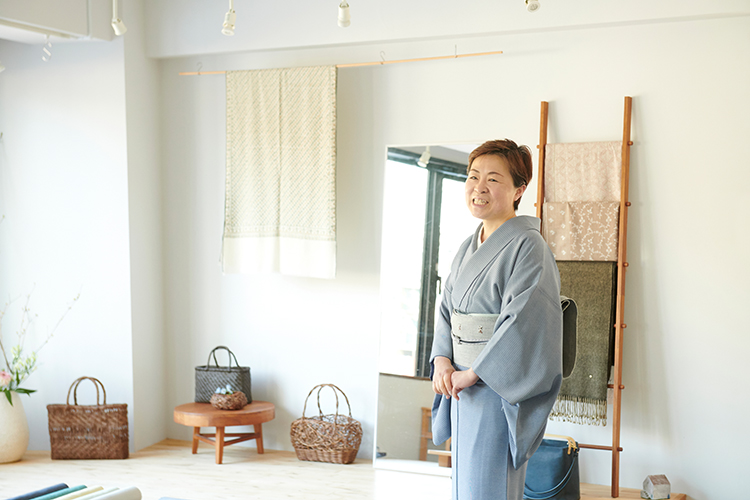
Itonosaki owner Abiru Megumi
Covid has transformed our lives in many ways. The piece of tableware that Megumi shares with us here is one of the items that appear frequently on her dining table now that she eats at home more often.
“When having a beer with dinner, we used to pour it into a glass, but we wanted to add a new twist to our meals at home. So for a change of mood, we’d amuse ourselves by using other vessels in place of a glass, like the cup you dip your soba noodles in. Then one day we tried drinking beer from a yunomi (handleless tea mug), and it tasted delicious. The yunomi mellows the beer because it’s so thin and feels pleasant on the lips. My husband agrees with me. Now we always drink beer from these mugs.”
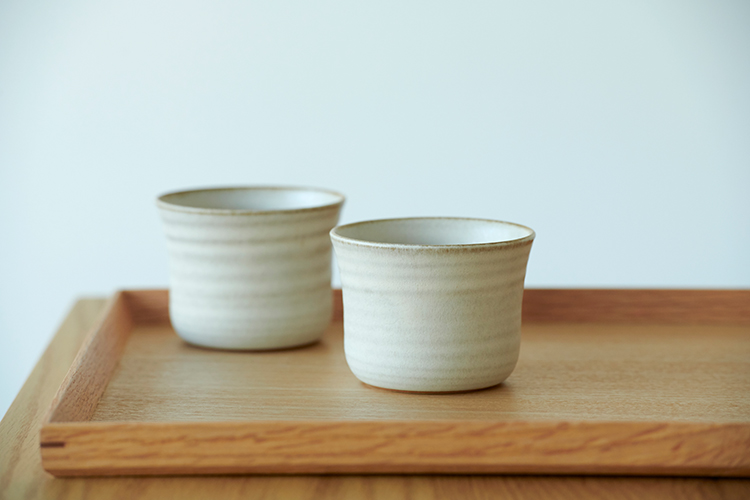
A pair of yunomi with eggshell glaze made by Mino Daisuke. They have a beautiful shape designed to be practical. They can even be stacked.
The yunomi in question is made by Mino Daisuke, who runs a pottery workshop called Hachidori in Nara. Dinner at the Abiru home typically consists of small portions of food accompanied by beer or wine. And Mino Daisuke’s yunomi mugs aren’t the only dishes of his that grace the Abiru dining table.
“Mino-san’s tableware is perfect for serving an assortment of snacks in small dishes. I basically like small items of tableware. Japan has always had a culture of serving a variety of foods on small plates — take kaiseki, for example. There’s nothing wrong with serving a meal on a single large plate. But serving small portions of a variety of foods allows you to enjoy different combinations and how they go together. When eating becomes a multisensory experience, it enriches your day-to-day life.”
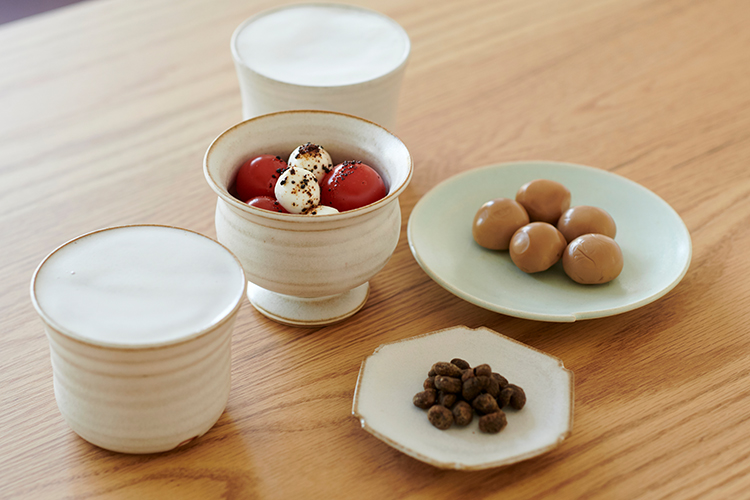
Gently pouring beer into these yunomi mugs results in a fine froth. The small plates and dessert cup add a dash of style to an evening drink.
For this feature, Megumi served several treats that often accompany an evening drink at the Abiru home: quail’s eggs; a mozzarella and cherry tomato salad; and hama natto, a type of fermented soybeans for which the city of Toyohashi in Aichi Prefecture is renowned.
“I’m particularly fond of the hama natto. Its rich umami flavor and salty taste make it the perfect beer snack. It’s highly nutritious because it’s fermented, so a small plate of it appears on our dining table virtually every day. Another mainstay of our meals these days is mozzarella and cherry tomato salad drizzled in olive oil containing chopped hama natto. The dish it’s served in here was made as a dessert cup, but I often use it instead of a small bowl for serving meal items.”
Megumi doesn’t restrict herself to using a particular dish for a particular food. She likes to experiment.
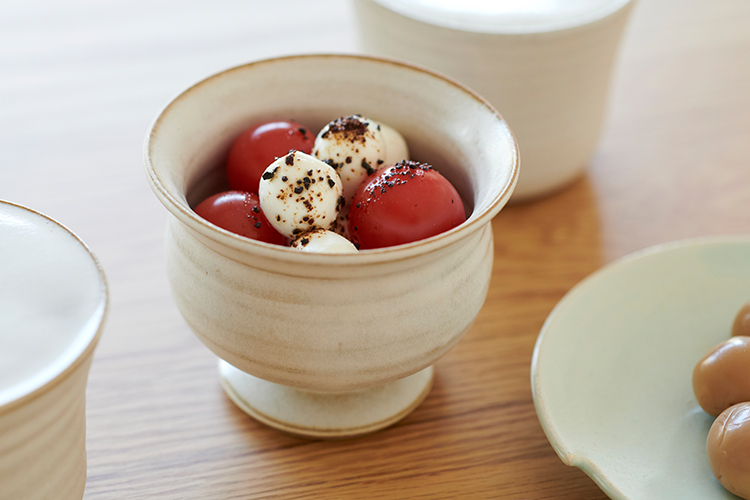
“It’s okay to put salad in a dessert cup, and it’s okay to pour coffee in a yunomi mug or serve yogurt or ice cream in it. Beer tastes excellent in a yunomi too, as I discovered from being confined to home. Experimenting with serving things in different dishes than you ordinarily would makes the same old food look fresh and exciting.”
Megumi first fell in love with Mino Daisuke’s pottery about two years after Itonosaki opened. It all started when she came across his Instagram page.
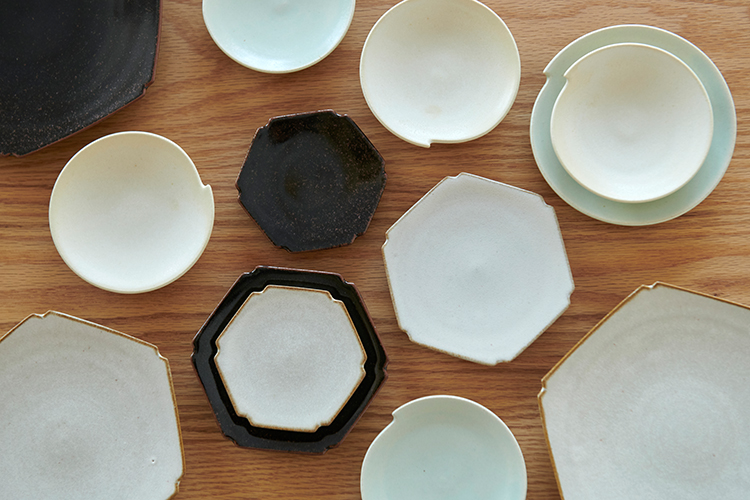
Mino Daisuke’s wares assume a completely different character depending on how you combine them. “The beautiful color of the glaze is alluring as well,” Megumi observes.
“The wares posted on his Instagram feed were so beautiful. They really struck me. I would often ‘like’ them. Then one day he happened to be in Tokyo for an exhibition and showed up unannounced at the store. Later, I got to actually turn over his ceramics in my hands and use them myself, and Itonosaki began carrying them. Social media sure is handy [laughs]. Since then, they’ve been part of our regular collection. We also regularly hold exhibitions of his works. I guess it was meant to be.”
I ask Megumi what she most likes about Mino Daisuke’s wares. “They combine the advantages of being handmade and being mass-produced,” she replies.

“Mino-san makes his pottery on a wheel. Each of his pieces therefore has a quality that only something handmade possesses. But he doesn’t just leave everything to nature. Having received a thorough grounding in the basics at a workshop with a multi-chamber ascending kiln, he has the skills to produce the same item over and over. His wares come in incremental sizes: three sun, four sun, five sun [a sun is approximately 3.03 centimeters]. If you break a dish, you can buy an identical one to replace it.
“What’s more, his pieces are elegantly designed. They’re sleek, feel good on the lips, and fit easily in the hand. And he diligently researches his glazes. His pottery displays a beauty and ease of use underpinned by technical excellence. Even the foot is polished completely smooth, so it won’t scratch your table. Using his wares, you realize they’re the work of a consummate professional.”
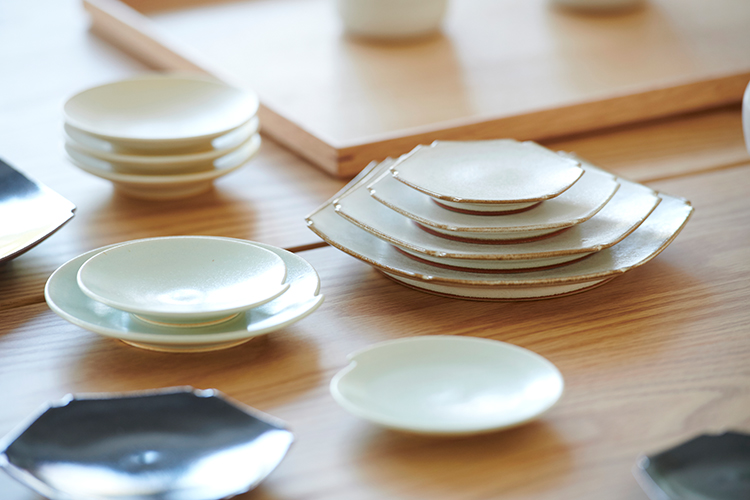
Megumi continues.
“I want to support people who obviously show a commitment to professionalism. In the old days, artists were patronized by wealthy merchants. But now, their works are bought piecemeal by individuals who can see the artist’s dedication and skill and have an urge to support them, who are attracted by the beauty of their creations. Such sentiments on the purchaser’s part become known to the artist in turn, leading to the output of more fine pieces. This cycle is what professionalism is built on. It’s how I like to choose things myself. Here at Itonosaki, we want to set that cycle in motion.”
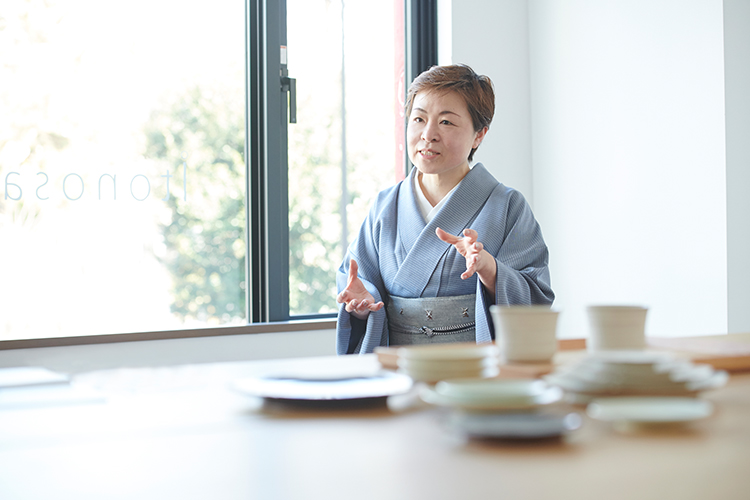
Above all, Megumi believes in things that speak to the heart.
“Not everything that’s handmade speaks to the heart. A piece can be perfect and still fail to do so. Some things, I feel, speak to the heart and others don’t, even if they look the same and appear identically made. What makes a piece speak to the heart, I believe, are the artist’s life experiences, their cumulative day-to-day hard work, their location, their passion for their craft, and numerous other factors like that. That’s why I like to visit the site of production and see it with my own eyes. I hope that customers, too, will get to know each piece’s background.
“People may be getting out less these days. But having things around you that speak to the heart can enrich your life at home. These are the things I want to tell our customers about and bring to them.”
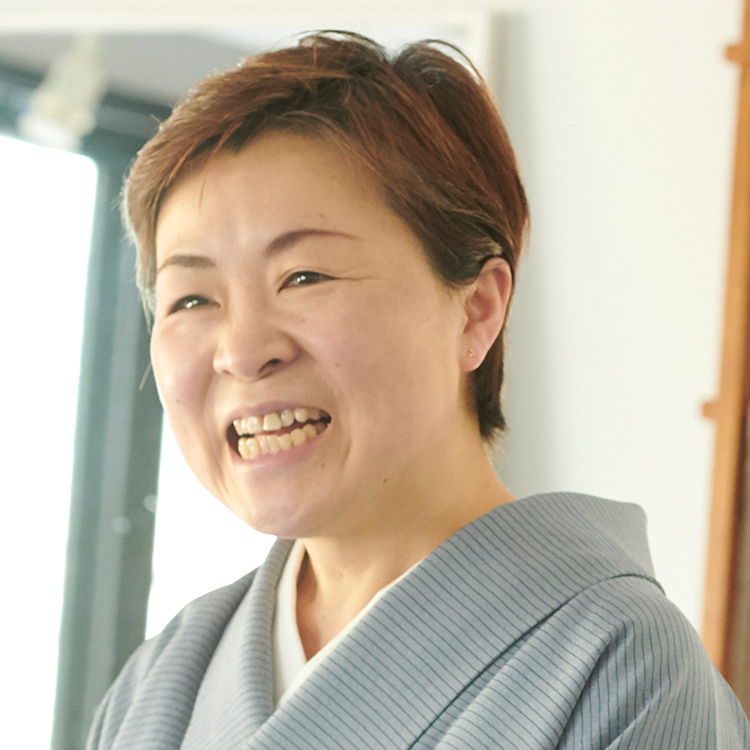
Abiru Megumi became owner of the curated gallery and shop Itonosaki after working as a patternmaker, in a pottery shop, and at a kimono store. Since launching Itonosaki in 2014, she has brought people a wide range of goods and experiences that give a sense the dedication and commitment that artists put into their work. In fall 2020, Itonosaki opened a new exhibition area called Itonosaki▷+plus, where artists and customers can interact.
mail:info@itonosaki.tokyo
https://www.instagram.com/itonosaki